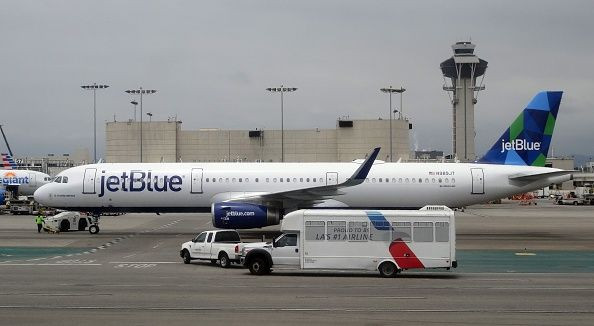JetBlue Earnings Soar Again, But Revenue Challenges Return

Three months ago, JetBlue Airways (NASDAQ:JBLU) reported that adjusted earnings per share soared 62% year over year to $0.60, driven by a combination of solid unit revenue growth and strong cost control. At the time, the company's third-quarter forecast implied that EPS would continue rising rapidly.
On Tuesday morning, JetBlue did report strong EPS growth for the third quarter. However, its results still fell short of what its original guidance had implied. Moreover, EPS trends are set to worsen in the fourth quarter due to ongoing deterioration in the airline's revenue per available seat mile (RASM).
Strong cost performance, but unit revenue weakens again
Back in July, JetBlue expected modest 0.5% to 3.5% RASM growth in the third quarter, despite a steep downturn in leisure travel to the Dominican Republic, particularly Punta Cana. However, in early September, the company slashed its revenue guidance by 3 percentage points at the midpoint, calling for a 0% to 2% decline in RASM. Management pointed primarily to weaker bookings in Puerto Rico, along with headwinds from Hurricane Dorian and a deceleration in domestic fare gains.
Ultimately, JetBlue's RASM fell 0.9% year over year for the quarter, in line with its updated forecast. Notably, domestic RASM rose about 3%, indicating that unit revenue plunged on routes to the Caribbean and Latin America. The weakness in this region also caused the carrier's revenue trends in Fort Lauderdale to flip from outperformance in the second quarter to deep underperformance last quarter.
Fortunately, favorable cost trends more than offset the pressure on JetBlue's unit revenue. Adjusted nonfuel unit costs inched up just 0.3% last quarter, beating management's forecast of a 0.5% to 2.5% increase. Additionally, JetBlue's average jet fuel price fell to $2.06 per gallon from $2.32 per gallon a year earlier, and fuel efficiency improved by about 2%.
The net result was that JetBlue's adjusted pre-tax margin improved to 11.4% from 9% a year earlier. This caused adjusted EPS to soar 40% year over year to $0.59.
Trends continue in the fourth quarter
If anything, JetBlue expects its unit revenue trajectory to worsen in the fourth quarter. While domestic demand remains solid, airline industry capacity growth is starting to weigh on fares. JetBlue will also have to cope with a suboptimal schedule during Q4 due to aircraft delivery delays.
On the bright side, unit revenue trends should improve sequentially in Latin America and the Caribbean this quarter, thanks to capacity adjustments by JetBlue and its peers. Nevertheless, JetBlue expects RASM to decline 0.5% to 3.5% for the quarter.
JetBlue does expect its solid cost trends to continue in the fourth quarter. Nonfuel unit costs should be flat year over year, plus or minus 1 percentage point. Furthermore, JetBlue expects to pay $2.07 per gallon for jet fuel -- down from $2.24 per gallon in Q4 2018. Still, this forecast implies that EPS growth will slow dramatically, or stop altogether, in the current quarter.
The longer-term outlook remains very favorable
Despite the setback expected this quarter, JetBlue executives reiterated their confidence that the company will achieve its 2020 earnings goal of $2.50 to $3 per share. Considering that EPS is on track to fall short of the $2 mark this year, reaching this target would require a huge acceleration in JetBlue's earnings growth.
That's not as far-fetched as it may seem. JetBlue is set to roll out "Fare Options 2.0" -- its version of the basic economy pricing that most U.S. airlines have adopted in recent years -- later this quarter. JetBlue will capture most of the anticipated $150 million revenue benefit next year. Moves to reallocate capacity from underperforming markets to stronger ones could provide an additional revenue boost of $50 million or more. Finally, ongoing fleet changes and structural cost reductions should enable JetBlue to reduce its nonfuel unit costs and improve its fuel efficiency on a year-over-year basis in 2020.
Even if EPS comes in near the low end of JetBlue's guidance range next year, investors still have a lot to look forward to in the years beyond 2020. Most notably, JetBlue's initiative to add seats to its Airbus A320s, and the growth of its A321neo fleet, should enable incremental unit cost reductions in 2021. The replacement of its Embraer E190s with a new fleet of A220s will drive additional savings in the following five years.
With JetBlue shares still trading for less than 10 times earnings, these future earnings catalysts give the stock a ton of upside in the years ahead.
This article originally appeared in the Motley Fool.
Adam Levine-Weinberg owns shares of Embraer and JetBlue Airways. The Motley Fool recommends JetBlue Airways. The Motley Fool has a disclosure policy.




















